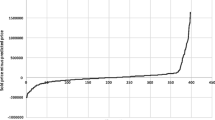Abstract
This paper studies a sales mechanism, prevalent in housing markets, where the seller does not reveal or commit to a reserve price but instead publicly announces an asking price. We show that the seller sets an asking price such that, in equilibrium, buyers of certain types would accept it with positive probability. We also show that this sales mechanism, with an optimally chosen asking price set prior to the seller learning her value, does better than any standard auction with a reserve price equal to the seller’s reservation value. We then extend the analysis to the case where the asking price reveals information about the seller’s reservation value. We show that in this case there is a separating equilibrium with fully-revealing asking prices, which is revenue-equivalent to a standard auction with a reserve price set at the seller’s reservation value.

Similar content being viewed by others
Notes
See Menezes and Monteiro (2008) Chapter 3, pp. 22–25.
See Ashenfelter (1989).
This is of course short hand for a more complex process where the seller has some information about the market value of their property, but updates that information once she observes the level of buyers’ interest.
As in Menezes and Monteiro (2003) who show that when auction entry is endogenous, bidders who enter the auction bid more aggressively than in a standard auction.
One can unify steps two and three as follows: in the event where only one buyer accepts the asking price, then the seller offers the maximum of her value and the asking price as a take-it-or-leave-it offer. This yields the same payoff to the seller as in the case analyzed above. See Appendix B for a formal analysis of this alternative modeling assumption.
In such auction each bidder controls a button, and by keeping the button depressed they indicate that they are active in the auction. The auctioneer increases the price continuously, and bidders leave the auction by releasing the button.
See Krishna (2002) Ch. 1, pp. 4–5.
Note that the seller setting an asking price equal to zero is equivalent to setting an asking price is equal to her value. Both cases are isomorphic to a standard second-price auction with a reserve price equal to the seller’s value.
For example, Han and Strange (2014) shows the number of properties sold in the US in which the transaction price exceeded the asking price tripled over the period from 1995 to 2005, and reached 30% of the total in some local markets
Cai et al. (2007) analyses a similar situation for a reserve price in an auction.
In this environment, there are other pooling and partial pooling equilibria. However, there are methods to eliminate them from the equilibrium set. For instance, we can use Banks and Sobel (1987), D1 criterion with the same argument as in Albrecht et al. (2016), to eliminate those equilibria from the set. For further refinement methods see Cai et al. (2007).
See Sect. 5.1.
Since \(b(0)=0\), and \(\underline{\underline{v}}>0\), we have \(F(s_{0})>0.\)
References
Albrecht J, Gautier PA, Vroman S (2016) Directed search in the housing market. Rev Econ Dyn 19:218–231
Arefeva A (2016) How auctions amplify house-price fluctuations. working paper
Ashenfelter OC (1989) How auctions work for wine and art. J Econ Perspect 3(3):23–36
Banks JS, Sobel J (1987) Equilibrium selection in signaling games. Econometrica 55(3):647–671
Cai H, Riley JG, Ye L (2007) Reserve price signaling. J Econ Theory 135(1):253–268
Carrillo PE (2012) An empirical stationary equilibrium search model of the housing market. Int Econ Rev 53(1):203–234
Case KE, Shiller RJ (2003) Is there a bubble in the housing market? Brook Pap Econ Act 34(2):299–362
Chen Y, Rosenthal RW (1996a) Asking prices as commitment devices. Int Econ Rev 37(1):129–155
Chen Y, Rosenthal RW (1996b) On the use of ceiling-price commitments by monopolists. Rand J Econ 27(2):207–220
de Wita ER, van der Klaauw B (2013) Asymmetric information and list-price reductions in the housing market. Reg Sci Urban Econ 43(3):507–520
Elyakime B, Laffont JJ, Loisel P, Vuong Q (1994) First-price sealed-bid auctions with secret reservation prices. Ann d’Econ et de Stat 3:115–141
Han L, Strange WC (2014) Bidding wars for houses. Real Estate Econ 42(1):1–32
Khezr P (2015) Time on the market and price change: the case of Sydney housing market. Appl Econ 47(5):485–498
Krishna V (2002) Auction theory. Academic Press, San Diego
Lester B, Visschers L, Wolthoff R (2017) Competing with asking prices. Theor Econ 12:731–770
Mathews T, Katzman B (2006) The role of varying risk attitudes in an auction with a buyout option. Econ Theor 27(3):597–613
Menezes FM, Monteiro PK (2003) Synergies and price trends in sequential auctions. Rev Econ Des 8(1):85–98
Menezes FM, Monteiro PK (2008) An introduction to auction theory. Oxford University Press, Oxford
Menezes FM, Monteiro PK, Ryan MJ (2005) Reserve price commitments in auctions. Econ Lett 87(1):35–39
Milgrom P, Weber R (1982) A theory of auctions and competitive bidding. Econometrica 50(5):1089–1122
Myerson RB (1981) Optimal auction design. Math Oper Res 6:58–73
Reynolds SS, Wooders J (2009) Auctions with a buy price. Econ Theor 38(1):9–39
Riley JG, Samuelson WF (1981) Optimal auctions. Am Econ Rev 71(3):381–392
Author information
Authors and Affiliations
Corresponding author
Additional information
Menezes acknowledges his senior research fellowship with the Australian Institute of Business and Economics at the University of Queensland.
We thank participants at the Econometric Society North American Winter Meeting 2016 and the Royal Economic Society meeting 2016. The usual disclaimer applies.
Appendices
Appendix A
Proof of Proposition 1:
The First order condition from the maximization of (4) at \(z=v\) yields:
This can be rewritten as:
The above differential equation can be solved with the boundary condition \( b(0)=0.\) To do so, we first multiply both sides of (24) by \( F^{n-2}(v) \):
We then use integration by parts of the right hand side to yield Eq. (5). Next we need to show that if the other \(N-1\) bidders follow this bidding function, then bidder i with value v would maximize her expected profit by bidding according to b(v). First, suppose bidder i with value v bids b(z). Then her expected payoff becomes:
Therefore, we have:
for any z greater or less than v. \(\square \)
Lemma 8.1
The equilibrium bidding function for the first-stage, b(v) is increasing in v if the following condition is satisfied.
Proof of Lemma 8.1:
From (24), we have:
Then, it follows that:
The numerator is clearly positive. If the denominator is also positive then b(v) is increasing. That is, we need that:
or
Another way to represent the above condition is:
It is easy to check that this condition is satisfied if both distributions are uniform.Footnote 18 \(\square \)
Proof of Proposition 2:
We need to show that the following differential equation has a unique solution:
Consider an initial point \(\underline{\underline{v}}\) such that, \(b( \underline{\underline{v}})=s_{0}\).Footnote 19 Let us rewrite the above equation as follows:
Continuity of \(b^{\prime }(v)\) requires:
or
At the initial point \(\underline{\underline{v}}=s_{0}\) we have:
Therefore, the Lipschitz condition is satisfied, that is, if \(b^{\prime }(v)=H(v,b(v))\), there exist a k such that:
We can then apply Picard’s theorem, which ensures that there is a unique solution around \(\underline{\underline{v}}\). To obtain a unique solution for our target interval, we define an initial point \(\underline{\underline{v}}\) such that \(\underline{\underline{v}}=\frac{s+v^{*}}{2}\). It follows that the continuity condition is automatically satisfied as b(v) is increasing in v. Beyond \(v^{*}\), \(b^{\prime }(v)\) becomes zero so the Lipschitz condition is no longer satisfied and we might have multiple solutions. However, these solutions are not equilibria as they are not in the defined interval. \(\square \)
Proof of Proposition 3:
We need to show that both \(\pi ^{1}\) and \(\pi ^{2}\) are increasing in v and
for every v greater than \(v^*\). But this is straightforward as:
and
The second equation is the differentiation of the term in (3) with respect to \(v_i\) at the point \(v^*\). Since \(\pi ^{1}=\pi ^{2}\) at \( v^{*}\), and \(\pi ^{1}\) is flat and \(\pi ^{2} \) is increasing in v for values higher than \(v^{*}\), then the uniqueness follows. \(\square \)
Proof of Proposition 4:
When the seller posts an asking price equal to zero, the game reduces to the case where \(v^{*}\) is equal to s. This is because the reserve price is now equal to s and only bidders with values above s would participate in the auction. It suffices to show the ex ante expected payoff at this point is increasing in \(v^{*}\). The differentiation of (11) at this point is:
It is possible to check \(\Pi _{1}(s,0)=\Pi _{2}(s,0)\). Thus, we have,
\(\frac{\partial \Pi _{2}(v^{*},s)}{\partial v^{*}}|_{v^{*}=s}\) is the differentiation of the expected payoff of an auction with respect to its reserve price. From Riley and Samuelson (1981) we know the optimal reserve price that maximizes the expected payoff is \(v_{*}=s+\frac{1-F(v_{*}) }{f(v_{*})}\) which is greater than s. Therefore, at \(v^{*}=s\) the expected payoff is increasing to its maximum. \(\square \)
Proof of Proposition 5:
First, it is easy to check that at \(p_{A}(\bar{v})\), the asking price mechanism is equivalent in an ex-ante sense (i.e., prior to the realization of the seller’s reservation value) to a first-price auction with a secret reserve price equal to the seller’s value. This is because no buyer would accept this asking price and all buyers would make a counter offer. According to Elyakime et al. (1994), proposition 1, a first-price auction with a secret reserve price is revenue equivalent to a first-price (or a second-price) auction with a public reserve price of \(b^{-1}(s)\). That is, the seller does not gain, from an ex-ante viewpoint, from keeping s secret. Finally, Proposition 4 shows that an optimal asking price mechanism does better, in expected revenue terms, than an auction with a reserve price s. It follows that the optimal asking price, \(p_{A}^{*}(v^{*})\), cannot be larger than or equal to \(p_{A}(\bar{v})\). \(\square \)
Proof of Lemma 6.1:
This follows the same steps as deriving the bidding function for a first-price auction with a reserve price equal to \(\hat{s}\). For instance, see Menezes and Monteiro (2008), Chapter 3, p. 23. \(\square \)
Proof of Lemma 6.2:
First we show b(v) is increasing in v.
Therefore, \(b^{-1}\) is also increasing and we have,
\(\square \)
Proof of Proposition 6:
To characterize the separating equilibrium, consider a \(\hat{s} \) such that,
Then we have,
According to (19) and (20), \( v^{\dagger }=\bar{v}\) is a solution. For every s, this gives an asking price equal to \(p_{A}(\bar{v},s)\), which is increasing in s. Equation (20) is the result of differentiating the total payoff with respect to \(\hat{s}\) when \(v^{\dagger }\) is constant. This is for simplicity as one can show that even if \(v^{\dagger }\) were to change, the outcome is still increasing in s and the single crossing continues to hold.
We further check whether any type wants to deviate from this equilibrium.
First, assume that a seller with value \(s_{2}\) wants to deviate and announces a lower type, that is, she posts an asking price \( p_{A}(v_{1},s_{1})\) with \(s_{1}<s_{2}\). In this case, \(\hat{s}=\) \(s_{1}\), and parts A and B of expression (18) correspond to the expected payoff of an auction with a reserve price equal to \(b^{-1}(s_{1})\). We also know that \(b^{-1}(s_{1})<b^{-1}(s_{2})\). Therefore, buyers with values between \(b^{-1}(s_{1})<v<b^{-1}(s_{2})\) submit bids that are less than the seller’s reservation value but can win the object with positive probability. But if the seller announces her true type via the asking price, that is, increases the asking price to \(p_{A}(v_{1},s_{2})\), then \(\hat{s}\) becomes equal to \(s_{2}\) and the sum of A and B will increase. Since both parts C and D are zero, the overall expected payoff increases by announcing the true type and no type benefits from announcing a lower asking price.
Second, consider the possibility that a lower type \(s_{1}\) deviates by setting an asking price of a higher type \(p_{A}(v_{2},s_{2})\), with \( s_{1}<s_{2}\). If \(v^{\dagger }=\bar{v}\), from (20) we know that no \(\hat{s}\) higher than the seller’s actual value is profitable as the differentiation of the expected payoff for \(\hat{s}>s\) is negative at \(v^{\dagger }=\bar{v}\). Thus, no type of seller would benefit by announcing a higher asking price. \(\square \)
Proof of Proposition 7:
Set \(v^\dagger = \bar{v}\) in Eq. (18) makes both C and D equal to zero. Since the seller signals her exact value via the asking price, that is, \(s=\hat{s}\), then part A and B are equivalent to the expected payoff of a first price auction with the seller’s value as the reserve price. \(\square \)
Appendix B
If we integrate steps 2 and 3, the model can be described as follows. First, all buyers decide to either make a counteroffer or accept the asking price. In the event where only one buyer accepts the asking price, the seller offers the maximum of her value and the asking price as a take-it-or-leave-it offer. All further steps remain as in the original model. Under this new assumptions, Eq. (3) changes to:
There is an addition term in 36 that captures the case where the asking price is lower than the seller’s value, but the buyer’s value is above the seller’s value. As in the original analysis, the optimal asking price is found by using the equivalence of the threshold type payoffs for making a counteroffer and accepting the asking price. That is, we have:
Solving (37) for \(p_{A}(v^{*})\) yields:
One can provide conditions under which the term above is increasing in \( v^{*}\). Under such conditions, we can characterize an equilibrium in which the seller’s optimal asking price is defined by (38). However, unlike in the basic model, \(b(v^{*})\) is no longer equal to \( p_{A}(v^{*})\). Since (38) is strictly greater than (7), it is straightforward to verify that (38) is also greater than \(b(v^{*})\).
Next, we consider how the seller’s payoff changes vis-à-vis the original model. When there is only one buyer, and the seller’s value is greater than the asking price, a sale will not occur and instead the seller will retain the object. In the new model and in the same event, the seller sells the object at its value. So in both cases the seller’s payoff remains the same. Also, when there are more than one buyers accepting the asking price, the both cases become equivalent. Thus, we can conclude that the seller’s payoff remains the same under both models.
Rights and permissions
About this article
Cite this article
Khezr, P., Menezes, F. Auctions with an asking price. Int J Game Theory 47, 1329–1350 (2018). https://doi.org/10.1007/s00182-018-0620-3
Accepted:
Published:
Issue Date:
DOI: https://doi.org/10.1007/s00182-018-0620-3




